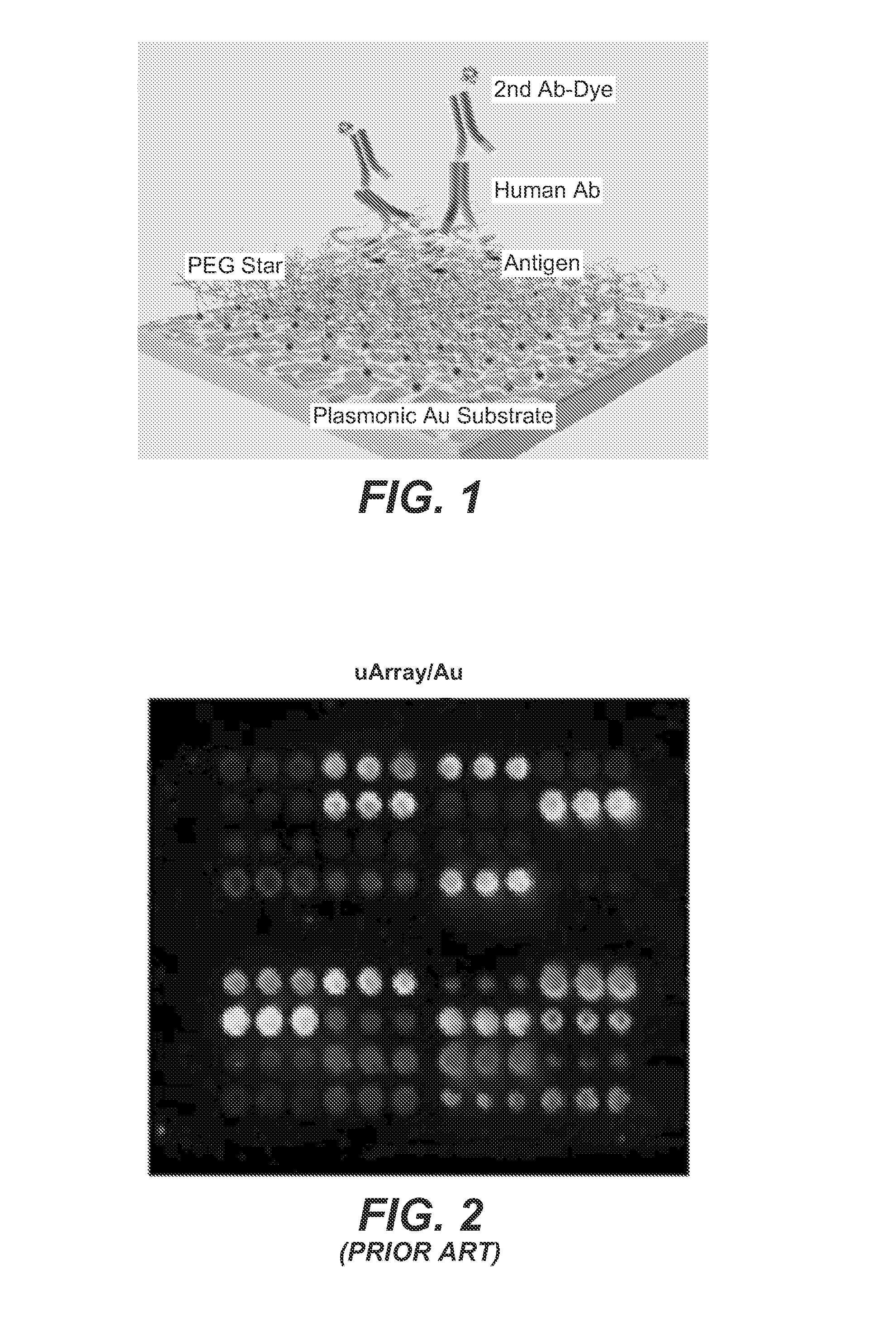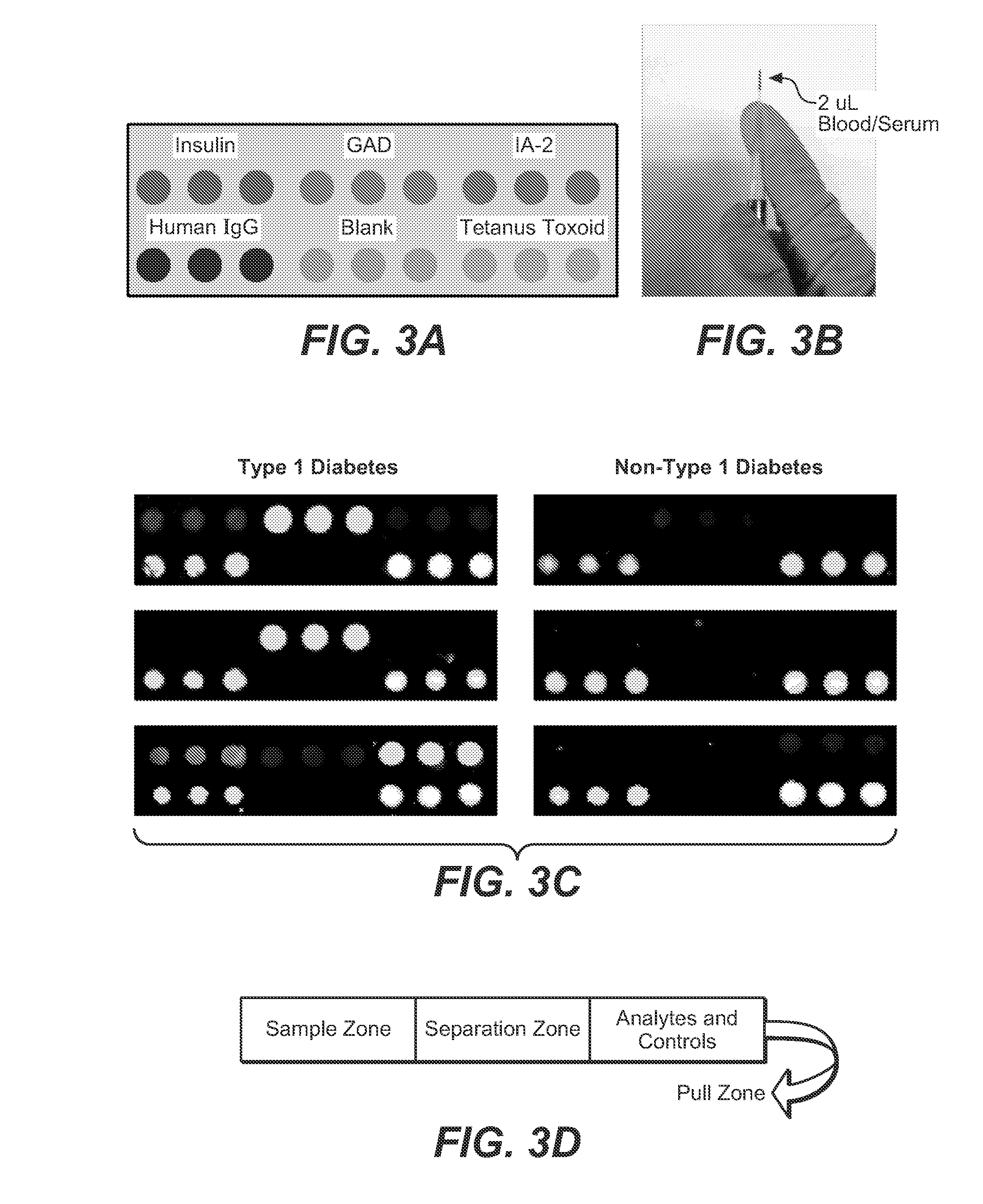Plasmonic substrate for multiplex assessment of type 1 diabetes
a plasmonic substrate and multiplex technology, applied in the field of nanostructured plasmonic metal films on substrates, can solve the problems of unsatisfactory diagnosis, no longer clear, up to 25% of children have unnecessary stress and health care expenditure, etc., and achieve the effect of detecting diabetes autoantibodies, rapid and sensitive diagnosis of diabetes, and equivalent sensitivity and specificity
- Summary
- Abstract
- Description
- Claims
- Application Information
AI Technical Summary
Benefits of technology
Problems solved by technology
Method used
Image
Examples
example 1
Plasmonically Active Au Substrates
[0068]Plasmonic nanostructured gold substrates are fabricated, and are capable of optimal fluorescence enhancement up to 1000 fold for NIR fluorophores, as described in the above-referenced patent application and publication by Tabakman et al. Chemical synthesis and lithographic patterning techniques are used for the formation of plasmonic gold films on glass capable of maximizing the fluorescence enhancement of NIR dyes coupled to antibodies to the diabetes autoantigens in a patient sample. The plasmonic resonance is controlled by the gold nanostructure patterns to match to emission of NIR fluorophores. Nano-gaps between gold nanostructures are tuned to maximize local electrical field enhancement for optimal NIR-FE for fluorophores such as cy5, cy5.5, Atto 647N, cy7, and IR800.
example 2
Detection of Diagnostic Biomarkers
[0069](Taken from copending Ser. No. 13 / 728,798). This example employs protein microarray printing onto a gold plasmonic substrate on a glass chip as described in the examples above. This array allows detection of autoantibodies in a patient sample. The antibodies associated with diabetes type I are raised against small volumes of antigen. The present array and use of the plasmonic substrate with enhanced near-infrared fluorescence provides significantly improved sensitivity, as the gold film amplifies the fluorescent signal labels on detection antibodies. Additionally, this platform allows for multiplexed testing for more than one diabetes autoantibody from a single patient sample, in addition to testing for diagnostic autoantibodies for other autoimmune diseases known to have increased prevalence in patients with type 1 diabetes from the same sample (including celiac disease, autoimmune hypothyroidism, and Addison disease).
example 3
Surface Chemistry for Applying Antigens for Effective Antibody Capture
[0070]While fluorescence-enhancement will enhance positive binding signal, effective surface chemistry on Au plasmonic substrates is used herein to immobilize capturing antibodies and prevent non-specific binding, thus optimizing positive binding and reducing background and false signal. We here modify the plasmonic gold film for immobilization of multiplexed protein probes by first making self-assembled monolayers (SAM) of thiol-containing molecules terminated with carboxylate groups. Branched hydrophilic polymers of 6-arm-poly(ethylene glycol) (PEG)-NH2 is then grafted to SAMs, followed by reaction with succinic anhydride to obtain carboxylic acid groups off the 6-arm-PEG for protein immobilization. This method is surprisingly advantageous, since it employs branched-PEG star polymers as a hydrophilic, biocompatible cushion (FIG. 1) on Au to allow oriented immobilization of protein probes with minimal conformati...
PUM
 Login to View More
Login to View More Abstract
Description
Claims
Application Information
 Login to View More
Login to View More - R&D
- Intellectual Property
- Life Sciences
- Materials
- Tech Scout
- Unparalleled Data Quality
- Higher Quality Content
- 60% Fewer Hallucinations
Browse by: Latest US Patents, China's latest patents, Technical Efficacy Thesaurus, Application Domain, Technology Topic, Popular Technical Reports.
© 2025 PatSnap. All rights reserved.Legal|Privacy policy|Modern Slavery Act Transparency Statement|Sitemap|About US| Contact US: help@patsnap.com



